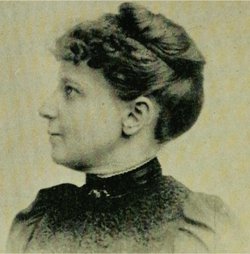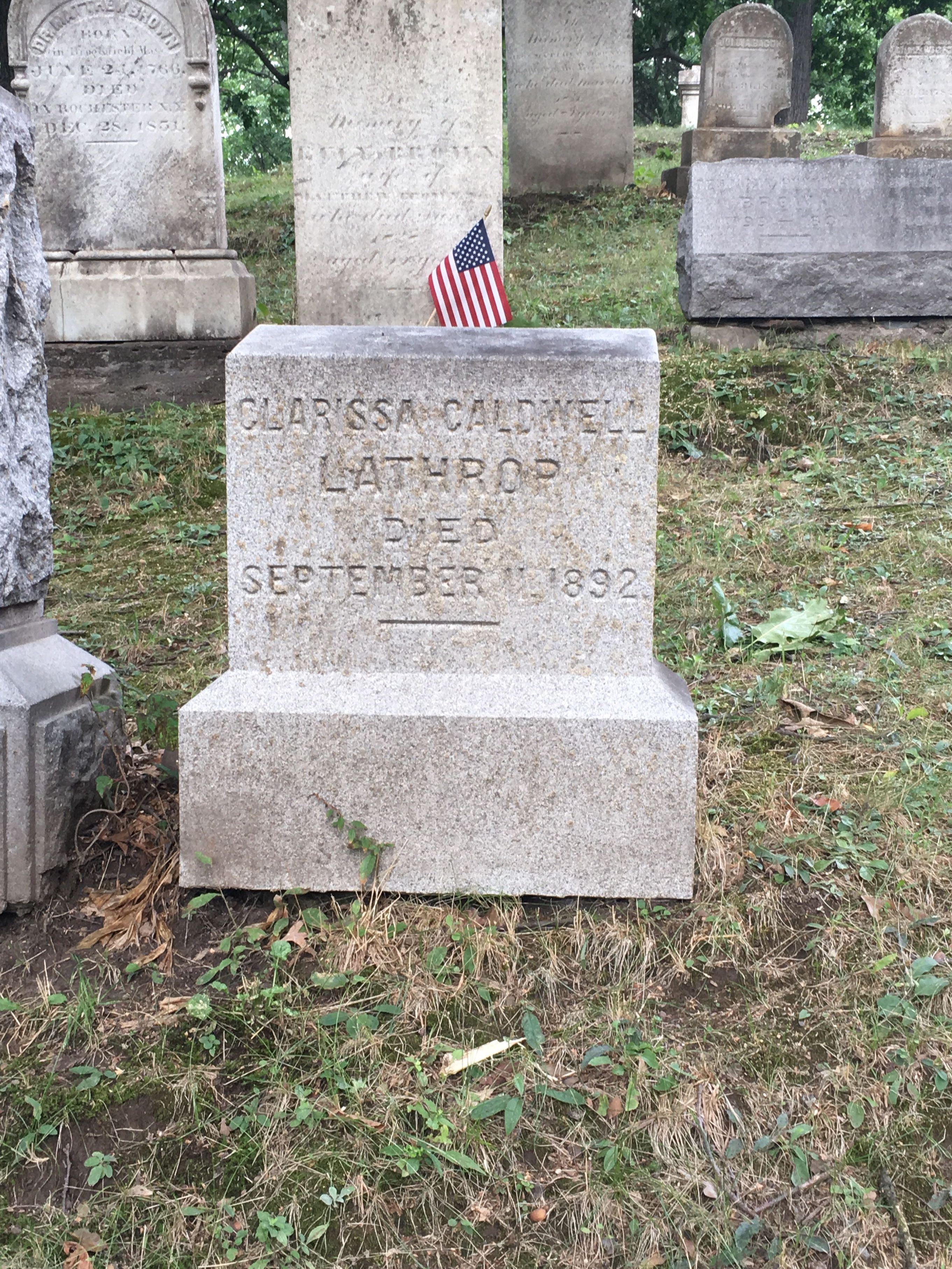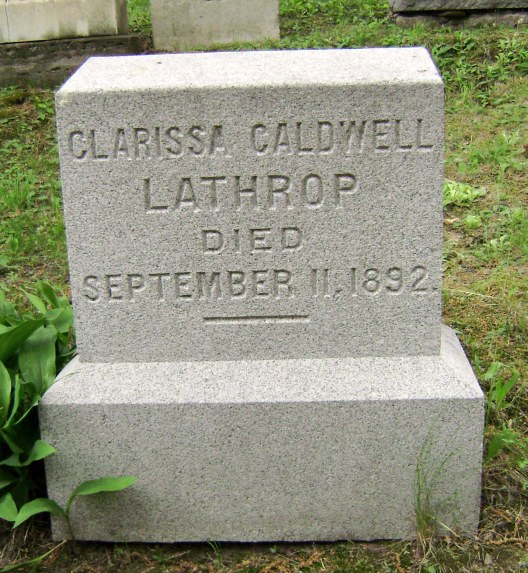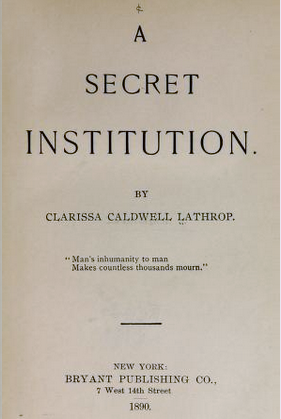She was committed on the diagnosis of a physician not well acquainted with her, after her mother and sisters complained to him of Clarissa's accusations regarding a female boarder in her mother's house. She was under the impression that the woman was trying to poison her on the instruction of the wife of a former lover.
She died at Seneca Springs, NY, aged just 40 years. Ironically, she is buried with her mother.
From the New York Times, December 20th 1890:
WILL SUE THE ASYLUM
MISS LATHROP ALLEGES THAT SHE WAS WRONGFULLY INCARCERATED
Miss C. C. Lathrop, who now lives in this city, was released from the State Insane Asylum at Utica a few years ago after having been incarcerated there for twenty-six months. She now proposes to sue the managers of the asylum for $25,000 damages, alleging that her detention was wrongful, that her efforts to effect her liberty were interfered with, particularly by the interception of her letters to her friends, and finally that she was treated with unnecessary harshness. She was, at last, by inclosing scraps of paper in balls or worsted, able to communicate with friends, who secured a lawyer for her, and he obtained her release on a writ of habeas corpus. Judge Barnard of the Supreme Court, upon hearing the evidence, ordered her discharge, stating that he was unable to detect in Miss Lathrop any indications of mental confusion.
She was sent to the asylum at the insistence of her mother and sisters, who live in Rochester, and who asserted that she was suffering from the delusion that somebody was trying to poison her. Her answer was that it was not a delusion, that somebody was endeavoring to poison her. But she was willing to accept proof to the contrary, which was also evidence that there was no delusion. Her incarceration ensued however, and in a book called "A Secret Institution", which she prepared after her release and published at her own expense, she describes the sufferings of a woman perfectly sane held in an institution for mad people, and tells of her many fruitless efforts to send word to her friends of her unhappy condition.
Her counsel, Albert Bach of 140 Nassau Street, said yesterday that the interesting point in the case was the question of the deprivation of Miss Lathrop's postal rights while in the asylum. She was not permitted to have writing materials, and even though she succeeded in obtaining them, the asylum authorities disposed of her letters as they pleased. The claim will be asserted that asylum managers have no such control over inmates as have prison managers; that the former institutions have more of the character of hospitals. Mr. Bach finds nothing in the by-laws of the Utica asylum giving the right to this close supervision. He says that there have unquestionably been many instances of wrongful incarceration, and that justice would seem to dictate that inmates of asylums should have access to the mails. There would of course be a good deal of trash, but it would be well worth while to endure that if information could be obtained to the release of a person improperly detained.
Miss Lathrop is about thirty-five years old. Her father was Gen. William E. Lathrop. She taught school up to the time that she was placed in the asylum.
She was committed on the diagnosis of a physician not well acquainted with her, after her mother and sisters complained to him of Clarissa's accusations regarding a female boarder in her mother's house. She was under the impression that the woman was trying to poison her on the instruction of the wife of a former lover.
She died at Seneca Springs, NY, aged just 40 years. Ironically, she is buried with her mother.
From the New York Times, December 20th 1890:
WILL SUE THE ASYLUM
MISS LATHROP ALLEGES THAT SHE WAS WRONGFULLY INCARCERATED
Miss C. C. Lathrop, who now lives in this city, was released from the State Insane Asylum at Utica a few years ago after having been incarcerated there for twenty-six months. She now proposes to sue the managers of the asylum for $25,000 damages, alleging that her detention was wrongful, that her efforts to effect her liberty were interfered with, particularly by the interception of her letters to her friends, and finally that she was treated with unnecessary harshness. She was, at last, by inclosing scraps of paper in balls or worsted, able to communicate with friends, who secured a lawyer for her, and he obtained her release on a writ of habeas corpus. Judge Barnard of the Supreme Court, upon hearing the evidence, ordered her discharge, stating that he was unable to detect in Miss Lathrop any indications of mental confusion.
She was sent to the asylum at the insistence of her mother and sisters, who live in Rochester, and who asserted that she was suffering from the delusion that somebody was trying to poison her. Her answer was that it was not a delusion, that somebody was endeavoring to poison her. But she was willing to accept proof to the contrary, which was also evidence that there was no delusion. Her incarceration ensued however, and in a book called "A Secret Institution", which she prepared after her release and published at her own expense, she describes the sufferings of a woman perfectly sane held in an institution for mad people, and tells of her many fruitless efforts to send word to her friends of her unhappy condition.
Her counsel, Albert Bach of 140 Nassau Street, said yesterday that the interesting point in the case was the question of the deprivation of Miss Lathrop's postal rights while in the asylum. She was not permitted to have writing materials, and even though she succeeded in obtaining them, the asylum authorities disposed of her letters as they pleased. The claim will be asserted that asylum managers have no such control over inmates as have prison managers; that the former institutions have more of the character of hospitals. Mr. Bach finds nothing in the by-laws of the Utica asylum giving the right to this close supervision. He says that there have unquestionably been many instances of wrongful incarceration, and that justice would seem to dictate that inmates of asylums should have access to the mails. There would of course be a good deal of trash, but it would be well worth while to endure that if information could be obtained to the release of a person improperly detained.
Miss Lathrop is about thirty-five years old. Her father was Gen. William E. Lathrop. She taught school up to the time that she was placed in the asylum.








